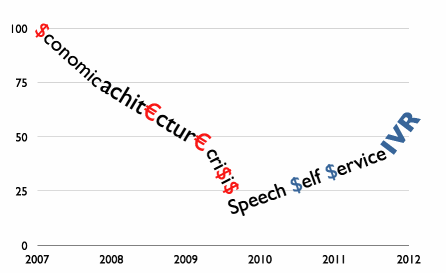
IVR technologies have been used for long time to help human call centers to manage better their internal resources (welcome mensages, call routing, call forwarding, queues’ menus…) than to provide services to callers as: Speech self-services. This interesting article is talking about the current wind of change of IVR usage. At I6NET, most of our main VXI* business cases are coming from Speech Self-services implementations where the open standard VoiceXML language is a high value-added technology to build advanced machine-human dialogs for many business processes.
In a time of economic uncertainty, when managers are being asked to do more with less, and when cost cutting has become the norm, the ability for IVR (Interactive Voice Response) to assist in accomplishing these objectives has never been more obvious.
Managers are being forced to make difficult choices between high-touch experience delivered by a live agent and low-cost automation delivered by IVR. It is well known that to process a call using a human agent can cost 5-10 times what it costs to answer a similar call using IVR. In the past, managers have chosen to deliver an enhanced customer experience over a much lower-cost automated option. So when it comes time to slash costs, IVR can play a key role. On the other hand its very important not to upset the balance between automation and customer experience. The answer is not to shift every human interaction to an automated interaction, or to use IVR to make it more difficult for customers to speak to a higher-cost live agent.
I would suggest that you start by taking inventory of all your customer interactions. Not only the obvious ones. Your inventory will allow you to prioritize by value contribution, revenue contribution, and cost of each interaction, and pinpoint where IVR can assist you to cut cost, and not significantly upset the balance.
Recently, I received a call from the director of marketing at a company in the health care sector, needing to cut costs by finding an alternative to live agents handling their Diabetes testing kit sampling program. As a sampling program, there was no linked revenue to the call, and the value to the caller was mostly in receiving delivery of the kit on time, which was advertised to over 2.5 million people. Although this was a highly successful program, based on response, fell under the cuts to the marketing budget. The company recognized that the calls could be handled using IVR, however as an untested alternative they wanted to run a short term pilot to measure the impact to the success of the program.
To minimize the risk the company opted for an outsourced IVR approach, which provided financial flexibility by not having to make a long term commitment. In addition, with reduction in the IT budget, outsourcing the implementation and hosting was a perfect match, allowing the company to control costs, and provide commitment flexibility.
Perhaps when the economy recovers, this company and many others alike will move back the high touch approach of live agents, however as hard economic times call for tough measures, IVR is playing a key role and helping managers accomplish their objectives.
By Barnard Crespi
Source: Adeptarticles – IVR: In a Time of Economic Uncertainty